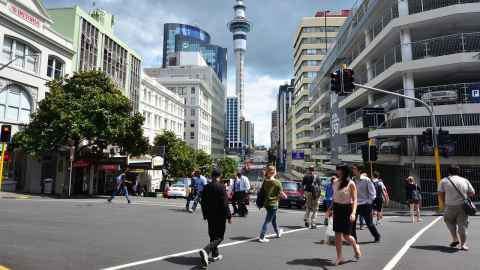Why aren’t we walking more?
18 August 2025
We often say we have no choice but to drive, but as it turns out, that’s often not true. Urban form enables walking but it doesn't guarantee people will, as I-Ting Chuang explains.

Most of us would agree that walking is the ultimate “win–win”: it costs nothing, keeps us healthy, reduces stress, fosters neighbourly interaction, and produces zero carbon emissions.
Yet even the shortest urban journeys are mostly made by car. Our 2018 Census reports 82.8 percent of trips made in Auckland were by car. If we all know walking is good for people and the planet, why don’t we walk more?
In New Zealand, we often say we have no choice but to drive, but as it turns out, that’s not necessarily true.
To see whether urban form itself is a barrier to walking, we carried out a preliminary investigation into how our urban structure may discourage walking by mapping 15-minute walking catchments in two Auckland neighbourhoods and four Hamilton neighbourhoods (Hamilton being one of New Zealand’s most car-dependent cities).
We were pleasantly surprised to find that many suburbs met the ’15‑minute city’ ideal, in which shops, cafés, schools, and parks are all within a 15-minute walk. However, that proximity failed to translate into foot traffic.
What we did find is that in well-connected areas, only a small fraction of people walk to where they want to go; conversely, people in poorly served suburbs walk more often because they have to. This disparity shows that urban form enables walking, it does not determine it.
In linear or suburban districts, greenery and scenic pathways draw people out, turning discretionary strolls into daily habits. In areas dominated by a single facility type, such as a continuous retail strip, we see people’s willingness to walk flatline ...
What else is shaping walking behaviour?
Our team investigated this question by analysing millions of anonymised mobile‑phone data points. We identified three interlocking drivers of walking behaviour.
First, we found that street network continuity was important, that a fine-grained street network makes a five-minute walk feel achievable. The second feature was the presence of practical everyday destinations, such as corner stores, cafés, libraries and community centres – places that give people somewhere to go. The third driver was natural and designed features – trees, pocket parks, benches, and thoughtful lighting – which makes walking a pleasurable experience. Of these, access to destinations (places to go) emerges as the most powerful motivator: an elegant footpath won’t get people walking if there is nothing worth walking to.
Not all pathways are made equal, with under-served communities often contending with disconnected footpaths, poor lighting, and few local shops. In our study of Auckland’s walking patterns, we found that the suburbs with the highest levels of foot traffic were populated by people who had to walk to get where they needed to go, rather than choosing to walk for the pleasure of it.
The foot traffic in affluent neighbourhoods, by contrast, with leafy boulevards and vibrant high streets was more commonly populated by people walking for pleasure. That is, people chose to walk because it’s a pleasant thing to do, not because they had to.
We are hypothesising that these people ‘want’ rather than ‘have’ to walk, because online shopping, online meetings, online GPs and working remotely are all possible now. Whether they chose to walk was more influenced by things like street design, safety, greenery, and the general feel of the place.
Addressing this divide requires first meeting basic pedestrian needs, then layering on amenities that make walking genuinely attractive, such as trees, places to sit and so on.
The relative importance of each driver shifts with context. In tightly woven inner suburbs, people seem to walk more when there’s a sense of connectivity: a grid layout makes errands feel within reach, but less so when a destination involves a long straight strip of pavement.
In linear or suburban districts, greenery and scenic pathways draw people out, turning discretionary strolls into daily habits. In areas dominated by a single facility type, such as a continuous retail strip, we see people’s willingness to walk flatline, underscoring that diversity within a connected network is essential to sustain walkability.
Identifying the ways urban design can get people out of their cars and onto their feet is complicated, and contingent upon context. It demands place‑sensitive interventions. In areas where the population really has no choice but to walk, the priority should be safety, and continuous links to essential services.
In suburbs that have been designed to prioritise the car, we could improve pedestrian paths by retrofitting intersections and ensuring destinations are evenly distributed within a suburb, rather than concentrated in a single core or along a strip.
To foster a true walking culture, infrastructure and leisure ‘extras’ must advance hand in hand. Aligning shops and cafés along direct walking routes, enriching streetscapes with greenery and seating, and treating natural elements as critical infrastructure (not decoration) will make walking both possible and appealing for every community. Structure enables walking; experience drives choice.
Prioritising people over cars takes political consensus, steady budgets, and a willingness to rebalance road space. Upgrading and maintaining footpaths, planting and caring for street trees, and keeping lighting and signage in order all carry ongoing costs. The challenge is not merely building better footpaths or planting trees but convincing everyone, from policymakers to motorists, that streets designed for people are worth the investment.
The research described in this article was co-authored by Danjie Shen
Dr I-Ting Chuang is a senior lecturer at the School of Architecture and Planning, Faculty of Engineering and Design.
This article reflects the opinion of the author and not necessarily the views of Waipapa Taumata Rau University of Auckland.
This article was first published on Newsroom, Why aren’t we walking more?, 18 August, 2025
Media contact
Margo White I Research communications editor
Mob 021 926 408
Email margo.white@auckland.ac.nz